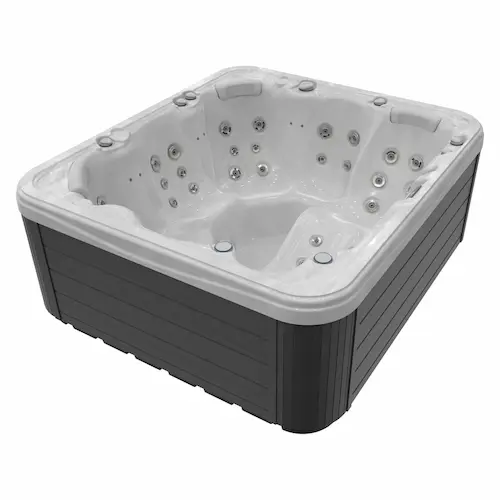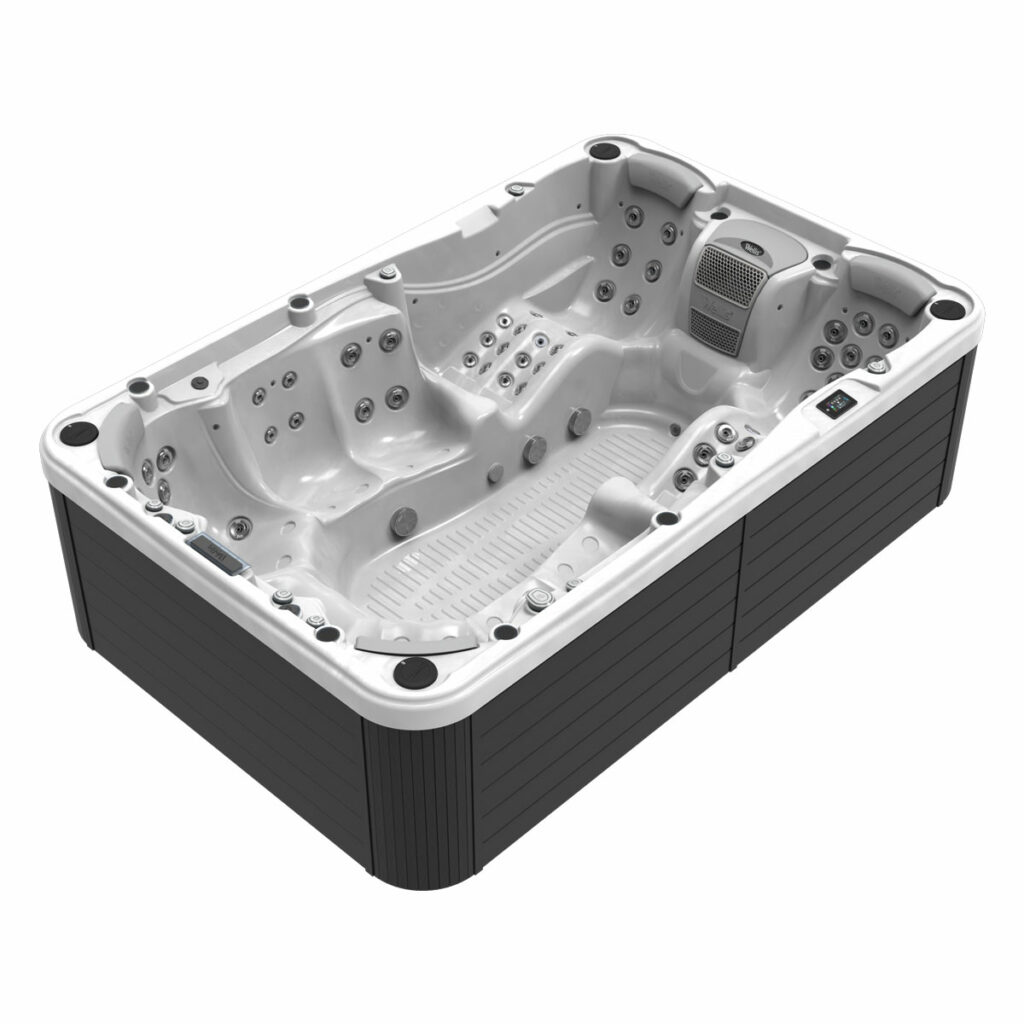Unwinding for a few hours in a hot tub is enough to make you feel light as air, floating past the stress of daily life and into a dreamy world of massage jets and soothing water sounds. In fact, when most of us think of hot tubs, we only think of that weightlessness—but the truth is that understanding the actual weight of a hot tub is just as important as making sure you can relax in it. So, how much does a hot tub weigh? This is essential for proper installation, structural considerations, and ensuring that your property can support this luxury without any unwanted surprises.
In this article, we’ll delve deeper into the answer to the question: “How much does a hot tub weigh”, including the factors that influence their weight, the different types available, and just how important it is to consider before installing your new hot tub.

Table of Contents
Hot Tub Weight Factors
When answering the question, "How much does a hot tub weigh," it's important to understand the factors that impact its weight - with and without it being full of hot, bubbling water and relaxed guests. If you don't take weight into consideration before purchasing and placing your new hot tub, you may encounter some issues down the line. If you place a heavy hot tub directly onto soft grass or sand, it will likely sink. If you place your hot tub on a deck, it could come crashing through if not properly reinforced.
It's essential to know how much your specific hot tub model weighs before you purchase and install the spa. Here are the factors that impact how much a hot tub weighs.
1. Size and Capacity
Hot tub size and capacity are two fundamental factors that significantly influence the weight of a hot tub. The correlation between these elements is obvious: the larger and more spacious the hot tub, the heavier it becomes. Let's break down how size and capacity contribute to the weight of these aquatic marvels.
Firstly, size plays a crucial role. The dimensions of a hot tub encompass its length, width, and depth, all of which contribute to its overall size and, consequently, its weight. A larger hot tub requires more materials for its construction, including a more substantial shell, frame, and additional insulation. This naturally results in an increase in weight. Larger hot tubs also have a greater water-holding capacity, which adds a substantial amount to their overall weight when the tub is filled.
Capacity, on the other hand, is closely tied to the number of occupants a hot tub can comfortably accommodate. The more people a hot tub is designed to hold, the larger its seating area, and the more water it must hold to ensure an enjoyable soaking experience. This increase in water volume, combined with the additional structural support needed for a higher capacity, significantly contributes to the tub's weight. It's important to remember that the weight of the water alone can be substantial; for instance, a hot tub designed for six to eight people may hold thousands of pounds of water when full, adding a considerable load to your installation site.
2. Material
Hot tubs are typically composed of several key components, and the choice of materials for each can vary greatly, influencing the overall weight of the unit.
One of the most substantial factors affecting weight is the tub's shell material. Hot tub shells are commonly constructed from either acrylic or roto-molded plastic. Acrylic, being denser and heavier, adds more weight to the hot tub, but it is also highly durable and resistant to damage. Roto-molded plastic, on the other hand, is lighter and more affordable, but it may not provide the same longevity or insulation properties.
The materials used for the frame, insulation, and cabinet also contribute to the tub's weight. A sturdy wooden cabinet or a robust metal frame adds mass to the hot tub, increasing its overall weight.
Similarly, the type and thickness of insulation used can make a notable difference. While better insulation can lead to energy efficiency, it often comes at the cost of added weight. It's important to note that these material choices not only affect the hot tub's weight but also its durability, energy efficiency, and long-term performance. Therefore, understanding the trade-offs between weight and other features is crucial when selecting the right hot tub for your needs.
3. Water and Occupants
Water and occupants are fluid (pardon our pun) factors that have a direct and significant impact on the weight of a hot tub.
Water is, by far, the most substantial contributor to a hot tub's weight. Depending on the size and capacity of the tub, it can hold hundreds to thousands of gallons of water. A gallon of water weighs approximately 8.34 pounds (3.78 kilograms). Consequently, when you fill your hot tub to its recommended water level, you are adding a considerable amount of weight to the structure.
The number of occupants in the hot tub also obviously further contributes to its weight. Each person in the tub adds their own weight, and while this may seem minimal compared to the water, it can make a difference. Larger hot tubs designed for more occupants naturally allow for a heavier load, but it's essential to be mindful of the manufacturer's guidelines for the maximum load capacity. Exceeding this limit can lead to safety concerns, affect the structural integrity of the hot tub, and even void warranties.
4. Features and Accessories
Additional features and amenities can also significantly affect its overall weight. Hot tub manufacturers offer a wide range of options to enhance your spa experience, which is often overlooked when buyers are considering how much their hot tub might weigh.
One common feature that can add weight is a hydrotherapy jet system. These high-powered jets are used to create therapeutic water streams and provide soothing massages. The installation of such a system requires additional plumbing, pumps, and often more robust structural support. The pumps and plumbing, in particular, can substantially increase the hot tub's weight, as they add not only the physical components but also the water they circulate.
Other features, such as built-in sound systems, LED lighting, and advanced control panels, also affect the overall weight. Sound systems include speakers and subwoofers, which add weight due to the materials and technology involved. LED lighting fixtures, while not particularly heavy on their own, can collectively contribute to the tub's overall mass, especially in models with extensive lighting features. Advanced control panels and automation systems may involve additional electronic components, which can increase the hot tub's weight as well.
Average Hot Tub Weight
It’s clear that hot tub weight varies greatly depending on the size of the spa, materials used to build it, and additional features included. So we can't offer a straight answer to the frequently asked question, "How much does a hot tub weigh?" That being said, we can provide a rough estimate of the overall average weight of hot tubs based on their size.
Small Hot Tubs (Two to Three People)
A small hot tub designed to fit two or three people, when not filled with water, can weigh anywhere from 400 to 700 pounds. With water, they can weigh significantly more, generally ranging from 2,000 to 3,500 pounds.
Medium Hot Tubs (Four to Six People)
A typical medium-sized hot tub—designed to accommodate four to six people—will likely weigh between 750 and 1,000 pounds when empty. When filled with water and occupants, that weight increases to approximately 5,000 to 6,000 pounds.

Milano Life P&P Hot Tub
The Milano Life P&P hot tub provides 4 comfortable seats and an incredible lounger, making it one of the most capable plug and play hot tubs for sale
Large Hot Tubs (Seven to Nine People)
A large hot tub without water can weigh anywhere from 800 to 2,000 pounds. With water, it can weigh substantially more, typically ranging from 6,000 to 10,000 pounds or more.

Olympus Hot Tub
As many as 9 people can comfortably relax in the Olympus hot tub that meets the highest needs. You may also enjoy the beneficial effects of warm water in this hot tub with 7 seats, 2 recliners, and a bevy of jets, ensuring a massage experience greater than ever before.
Extra Large Hot Tubs (More than 10 People)
Generally, an extra-large hot tub without water can weigh in the range of 1,500 to 3,000 pounds or more. When filled with water, the weight can be substantial, typically coming in at between 8,000 to 15,000 pounds.
Hot Tub Installation Considerations
The weight of your hot tub is not just a matter of curiosity; it's also a crucial factor to consider during the installation process. Before installing a hot tub, you should:
Determine the Weight Capacity of Your Foundation
The first step is to determine the weight capacity of the area where you intend to install your hot tub. You can usually find this information in your property's architectural plans or consult with a structural engineer. The weight capacity is essentially the maximum load that the foundation can safely support without risk of sinking or damage.
Assess the Foundation Material
Depending on your location and specific setup, the foundation may be made of concrete, reinforced decking, or a dedicated spa pad. Inspect the condition of the foundation, looking for cracks, erosion, or any signs of structural instability. The foundation should be level and free of any visible defects. If you notice any issues, it's crucial to address them before proceeding with the installation.
Consider Soil Composition
If your hot tub will be placed on soil, you must assess the soil composition. Different soils have varying load-bearing capacities. Consult with a geotechnical engineer if necessary to evaluate the soil and determine if it can support the weight of the hot tub. Soil tests may be needed to determine its load-bearing capacity accurately.
Calculate the Total Load
Calculate the total load the foundation must support, which includes the weight of the hot tub itself when filled with water, any added features, and the anticipated number of occupants. This sum should not exceed the weight capacity of the foundation, as exceeding this limit can lead to uneven settling, structural damage, and potential safety hazards.
Consult with Professionals
Before embarking on a hot tub installation, it is crucial to consult with professionals such as electricians, plumbers, and possibly even structural engineers.
Electricians play a critical role in hot tub installations, especially if the spa comes with intricate lighting, heating systems, and control panels. They can assess your existing electrical system to determine if it can handle the additional load required by the hot tub. If necessary, they can upgrade your electrical panel, ensure proper grounding, and establish GFCI (Ground Fault Circuit Interrupter) protection to reduce the risk of electrical hazards. Incorrect electrical work poses a serious danger, and having a certified electrician involved in the process ensures that your hot tub operates safely.
Plumbers are essential when it comes to the water supply and drainage aspects of hot tub installation. They can ensure that the plumbing connections are correctly fitted and that there are no leaks or issues with water circulation. Proper plumbing installation is not only vital for the functionality of the hot tub but also for preventing water damage to your property. A professional plumber can also assist with drainage solutions, helping you avoid problems like standing water or erosion around your hot tub area.
In some cases, it may be necessary to consult a structural engineer or a construction professional to assess the suitability of your foundation, especially if you plan to install a larger (and heavier) hot tub or if your location has particular soil conditions. Their expertise can help ensure that the foundation can safely support the weight of the hot tub and its occupants.
Consider Accessibility
Accessibility ensures that everyone, including those with mobility challenges, can safely and comfortably enjoy their hot tub.
The most essential aspect to think about when it comes to accessibility is the location of the hot tub. Ensure that it's easily accessible from your home, particularly for those with mobility aids or those who may have difficulty walking long distances. A level, well-paved pathway with proper lighting and handrails can make the journey to the hot tub more manageable.
The installation of non-slip surfaces around the spa and handholds to assist with getting in and out of the tub can also make your hot tub much more accessible. If budget and space permit, you may also want to explore the option of a lift or a hoist system to help individuals with limited mobility to access the water safely.
FAQ: How Much Does a Hot Tub Weigh?
How do you move a hot tub safely?
Lifting a hot tub safely is a task that demands careful planning and the right equipment. The key to safe lifting is to use specialized equipment designed for this purpose, such as spa movers or spa dollies, in combination with lifting straps or harnesses. These tools help distribute the weight evenly and prevent damage to the hot tub.
When it's time to lift the hot tub, enlist the help of a team of strong individuals who understand their roles and can lift in unison. Proper lifting techniques should be observed to prevent injuries, and it's crucial to move the tub slowly and cautiously, taking into consideration any obstacles or tight spaces.
How many people do you need to move a hot tub?
The number of people required to move a hot tub depends on the size, weight, and specific circumstances of the move. In general, a small hot tub designed for two to three people may require at least two to four strong individuals to safely lift and move it. Larger hot tubs designed for more people, such as those for seven to nine or ten or more occupants, will necessitate a larger team, potentially ranging from four to six or more individuals.
The key is to have enough people to evenly distribute the weight, coordinate movements, and avoid straining any one person. Additionally, using specialized equipment can make the task more manageable, reduce the required manpower, and enhance safety during the hot tub's relocation.
Can a deck handle the weight of a hot tub?
Whether a deck can handle the weight of a hot tub depends on a few factors, including the deck's construction, materials, and the size of the hot tub. Decks that are built to code with solid, well-maintained structures and support systems are more likely to bear the weight of a hot tub. However, it's essential to have the deck professionally assessed by a structural engineer or a licensed contractor to ensure it can support the specific load.
What is the best foundation for a heavy hot tub?
The best foundation for a heavy hot tub is, according to most experts, a well-constructed and level concrete pad. A concrete foundation provides exceptional support and stability, making it a good choice for the weight of a substantial hot tub. The pad should be at least 4 inches thick and reinforced with rebar for added strength. Properly prepared and level, a concrete pad offers durability and longevity, ensuring that the hot tub remains stable and secure over time.
What is the lightest hot tub option?
The lightest hot tub options are often inflatable or portable hot tubs. These models are designed to be lightweight, making them a practical choice for those seeking easy installation and mobility.
Inflatable hot tubs, for instance, can weigh as little as a few hundred pounds when empty, making them significantly lighter than traditional acrylic or fiberglass hot tubs.
Final Word: How Much Does an Average Hot Tub Weigh?
The weight of an average hot tub can vary based on its size, materials, and additional features. While it's challenging to provide an exact figure, estimates can serve as a general guideline when picking out your hot tub and preparing your foundation. No matter the size of your hot tub, understanding its weight is critical for a safe and successful installation.
When in the market for a hot tub, regardless of size, it's crucial to opt for a spa brand that enjoys a solid reputation. To find yours, you can make use of our spa dealer locator, explore online shopping options, or get in touch with Wellis® Spa at 844-4-WELLIS for personalized assistance in finding premium hot tubs and swim spas in your vicinity.

![Wellis Hot Tub Store in [cityst]](https://wellisspa.com/wp-content/uploads/Wellis-Hot-Tubs-in-Raleigh-Hero.webp)
